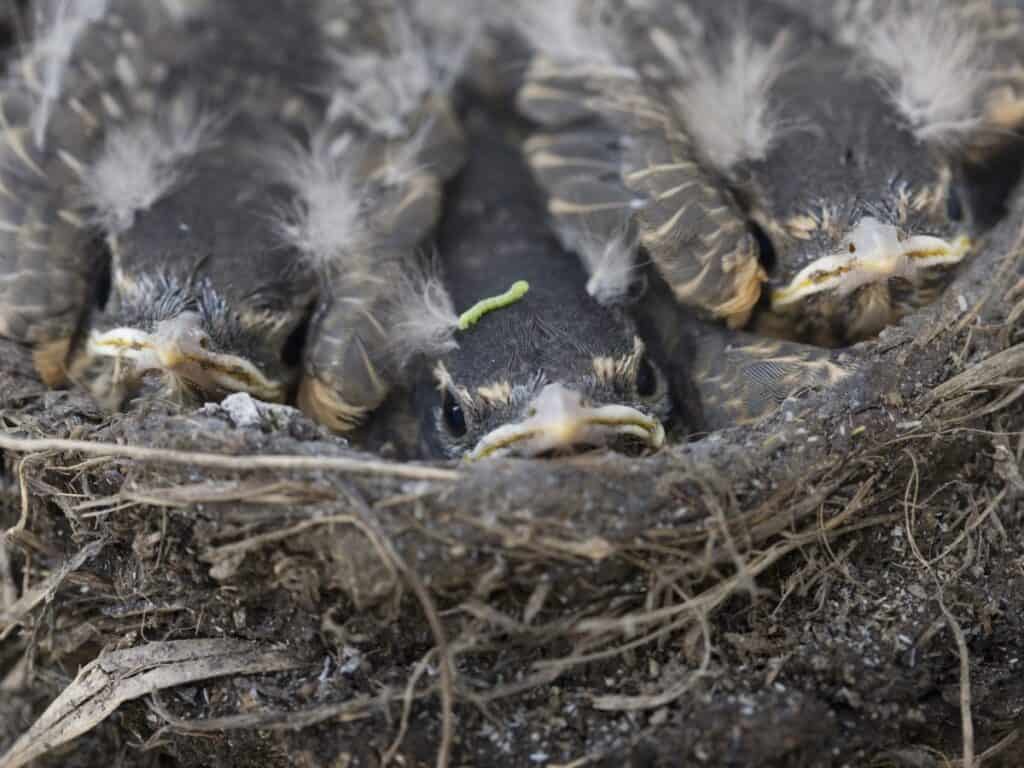As a bird enthusiast, I have always been fascinated by the feeding habits of baby robins. These adorable creatures are born helpless, with their eyes and ears closed, and rely entirely on their parents for food. But what exactly do baby robins eat, and how do their parents provide for them?
According to my research and personal experience, baby robins mainly eat insects and worms in the first few days after hatching. Their parents will break up the worms into small pieces, making it easier for the nestlings to swallow. As the babies grow, their parents will gradually increase the size and amount of food they provide, until the young robins are eating whole insects and worms on their own.

Understanding Baby Robins
Characteristics
Baby robins are small, delicate, and featherless birds that are born in nests made by their parents. They are pink and have closed eyes when they are born. Baby robins grow quickly and develop feathers in about three days. They have a distinctive orange breast and a brown back. They are about the size of a human thumb when they hatch, and they grow to be about six inches long.
Habitat
Baby robins are found in nests that are made by their parents in trees, bushes, and other elevated locations. The nests are made of grass, twigs, and other materials. The nests are usually hidden from view to protect the baby robins from predators.
Life Cycle
Baby robins are born in the spring and summer months. They are fed by their parents, who bring them insects, worms, and other small creatures to eat. Baby robins grow quickly and leave the nest about two weeks after they are born. They then learn to fly and hunt for food on their own. Adult robins mate in the spring and summer months and lay eggs in nests that they build. The eggs hatch after about two weeks, and the baby robins are born.
Overall, baby robins are fascinating creatures that have unique characteristics, habitats, and life cycles. By understanding these aspects of baby robins, we can better appreciate and protect these beautiful birds.
Baby Robins Diet
As a bird lover, I’ve always been fascinated by the eating habits of baby robins. In this section, I will discuss the diet of baby robins, including their favorite foods.
Insects and Spiders
Baby robins are primarily insectivores. They need a diet rich in protein to grow quickly and develop properly. Some of the insects and spiders that baby robins eat include mealworms, grubs, earthworms, crickets, grasshoppers, and beetles. They can also eat small spiders and caterpillars.
Berries
In addition to insects, baby robins also eat berries. Berries are an excellent source of vitamins and minerals. Some of the berries that baby robins eat include blueberries, raspberries, strawberries, and blackberries. They can also eat other fruits, such as apples and pears.
Earthworms
Earthworms are a favorite food of baby robins. They are high in protein and easy to digest. Baby robins can eat up to 14 feet of earthworms during their two-week nest life. As they grow older, their parents begin to let them eat whole worms and other large insects on their own.
In conclusion, the diet of baby robins is primarily made up of insects and spiders, berries, and earthworms. As a bird lover, it’s important to understand their dietary needs to help them thrive and grow properly.
Feeding Baby Robins
As a wildlife enthusiast, I have often come across baby robins that have fallen out of their nests. Feeding them can be a challenging task, but it is crucial to keep them healthy and safe. Here are some tips on feeding baby robins.
Frequency
When feeding baby robins, it is important to maintain a schedule. They require food every 15-20 minutes during the day, and every 45 minutes to an hour during the night. As they grow older, the frequency of feeding decreases.
Quantity
The amount of food a baby robin requires depends on its age and size. A general rule of thumb is to feed them 5-6 times their body weight in food daily. However, it is essential not to overfeed them as it can lead to health problems.
Technique
Feeding baby robins requires a delicate touch. A syringe or dropper can be used to feed them, but it is crucial to ensure that the food is not forced down their throat. The food should be placed in their mouth, and they should be allowed to swallow it on their own.
It is also important to provide them with the right kind of food. Baby robins require a diet rich in protein, and insects like mealworms, grubs, earthworms, crickets, grasshoppers, and beetles are excellent sources of protein. It is best to avoid feeding them fruits and seeds as they do not provide the necessary nutrients.
In conclusion, feeding baby robins requires patience, care, and attention to detail. By following the right feeding schedule, providing the right quantity and quality of food, and using the right technique, you can help them grow into healthy adult robins.
Risks and Precautions
Human Interaction
As a baby robin grows, it becomes more independent and starts to explore its surroundings. However, this can put the bird at risk of human interaction. It’s important to keep a safe distance from baby robins and avoid handling them. If you find a baby robin that appears to be abandoned, it’s best to contact a licensed wildlife rehabilitator for assistance.
Predators
Baby robins are vulnerable to a variety of predators, including cats, snakes, and birds of prey. To help protect baby robins from predators, it’s important to keep cats indoors and to avoid disturbing nests. If you notice a predator in the area, try to scare it away by making loud noises or using visual deterrents.
Dietary Imbalance
Feeding baby robins the wrong foods can lead to dietary imbalances that can harm their health. It’s important to feed baby robins a diet that is appropriate for their age and development. As baby robins grow, their dietary needs change, so it’s important to adjust their diet accordingly. Avoid feeding baby robins foods that are high in fat, salt, or sugar, as these can be harmful to their health.
In addition, it’s important to provide baby robins with fresh, clean water at all times. Dehydration can be a serious problem for baby robins, especially during hot weather. If you’re unsure about what foods to feed baby robins or how to care for them, contact a licensed wildlife rehabilitator for guidance.
Conclusion
In this article, I have discussed what baby robins eat at different stages of their growth. During the first few days, they depend entirely on their parents for food. The mother bird regurgitates tiny insects into the baby’s mouth. As the baby robin grows, its diet changes. It starts eating fruit, berries, and other small items.
The most common food a mother robin gives to her young is earthworms. They provide a great deal of nutrition. If you are raising the birds yourself, night crawlers found in fishing supply shops and some convenience stores are a perfect choice.
It is essential to remember that baby robins are delicate creatures, and feeding them the wrong food can be harmful. It is best to let their parents take care of them. However, if you find a baby robin that has fallen out of its nest, you can provide it with the right food until you can return it to its nest.
Frequently Asked Questions
What do baby robins eat besides worms?
Baby robins eat a variety of insects, including caterpillars, beetles, and grasshoppers. They also eat spiders, snails, and occasionally fruit.
What can I feed a baby robin?
If you find a baby robin that needs help, it’s best to leave it alone and let the parents take care of it. However, if you must feed it, you can offer mealworms, waxworms, or crickets. Avoid feeding it bread or milk, as these can be harmful to birds.
How do you feed a wild baby robin?
If you must feed a baby robin, use tweezers or forceps to offer small pieces of food. Hold the food near the bird’s beak and wait for it to open its mouth. Be careful not to force feed the bird, as this can cause it to choke.
How do you keep a baby robin alive?
If you find a baby robin that needs help, it’s important to keep it warm and quiet. Place it in a small box with a soft cloth or tissue and keep it in a warm, dark place. Do not offer it food or water unless it appears weak or dehydrated.
What do baby robins look like when they leave the nest?
Baby robins have spotted brown bodies and heads, and their underparts are lighter compared to older birds. They also have a distinctive white ring around their eyes. When they leave the nest, they are fully feathered and able to fly.
How can you tell how old a baby robin is?
You can estimate a baby robin’s age by its size and feather development. A newly hatched robin will be about 5-6 centimeters long and have no feathers. By the time it leaves the nest, it will be about 15-20 centimeters long and have fully developed feathers.
